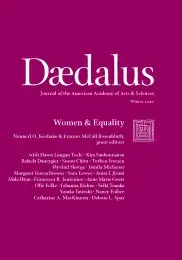The Dilemma of Gender Equality: How Labor Market Regulation Divides Women by Class
Women shoulder a heavier burden of family work than men in modern society, preventing them from matching male success in the external labor market. Limiting working hours is a plausible way to level the playing field by creating the possibility of less gendered roles for both sexes. But why then are heavily regulated European labor markets associated with a smaller share of women in top management positions compared with liberal market economies such as in the United States? We explain this puzzle with reference to the difficulty of ambitious women to signal their commitment to high-powered careers in regulated markets.
Despite a large influx of women into mainly service sector jobs over the past four decades, women continue to be underrepresented in the labor market, and they earn less on average than men. These gender differences are almost certainly linked to greater de facto responsibilities of women in child-rearing and household work, but there are major and intriguing differences across rich democracies.
In low- and mid-level jobs, the differences are fairly well understood. In Europe, union bargaining and wage compression put a higher floor under the lowest paid jobs where women disproportionately find themselves in every country. The gender gap in wages is smaller in Europe as a result, although another reason could be that low-productivity jobs may be scarcer. Regulated working hours, compatible with work-family balance, complements family-friendly policies such as public subsidization of childcare. Yet if this broadly accepted story is accurate, we should also expect the number of female managers of large firms and university-educated professionals to be rising as we travel from the United States and the United Kingdom to continental Europe and further north to Scandinavia. In fact, the reverse is true. Although the number is small everywhere, the share of women in high-powered private sector careers in the United States significantly exceeds that in Germany or Denmark. The explanation cannot be the long hours and inflexible schedules of professional work, since this is equally true in the United States. Also of no help are theories of occupational performance that predict greater female success in jobs requiring relationship management and multitasking, since these criteria characterize managerial jobs across the United States and Europe.
Our explanation instead focuses on unintended consequences: regulations that curtail working hours at nonmanagerial levels discourage employers from promoting women to higher levels, given that they have incomplete information about candidates. To employers who can measure productivity only imperfectly, long working hours are a signal–though a noisy one–of expected productivity and therefore of suitability for many kinds of higher-level managerial jobs. Labor market regulations tend to equalize both wages and employment opportunities for men and women when productivity is linked to hours worked, but it has the perverse effect of intensifying statistical discrimination against women in high-end jobs, even when these jobs are themselves unregulated. This logic explains the opposite effects of working-hours regulation at the low and high ends of the occupational hierarchy. Sadly, all good things do not go together, and labor market regulations produce good and bad results at the same time.
We begin by distinguishing jobs along three dimensions: 1) whether hours worked are positively associated with (hourly) productivity; 2) whether there are ample opportunities for promotions based on competition rather than seniority; and 3) whether working hours are regulated (restricted) below the management level.
As a general matter, low- and mid-level jobs may or may not be regulated in terms of working hours and wages, whereas top-end jobs are typically unregulated. While both women and men may have equal levels of ambition, family responsibilities are borne disproportionately by women in a way that reduces, on average, their availability to work around the clock (see Figure 1).
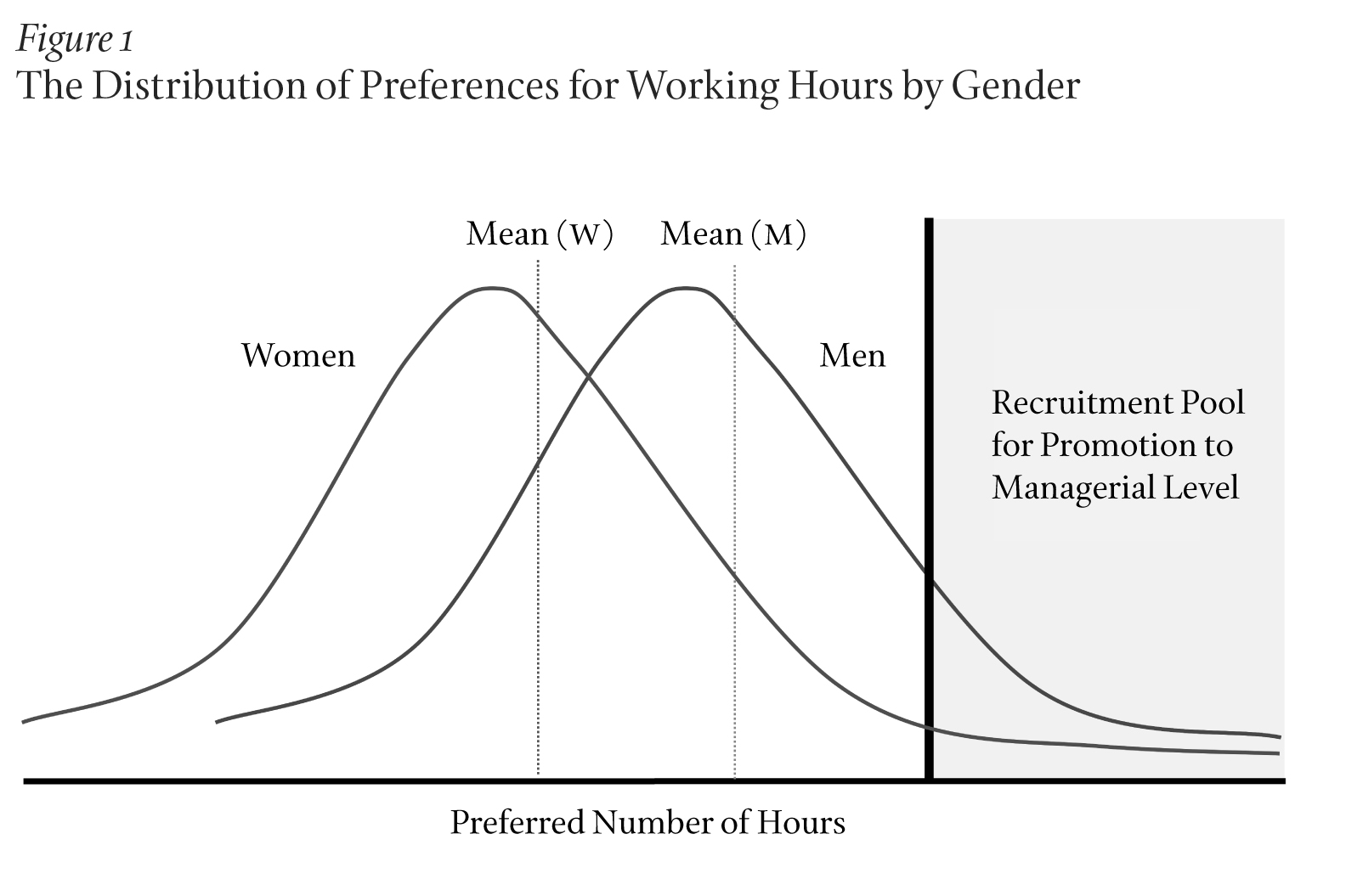
It is not difficult to see that, if the number of hours worked on average increases the worker’s productivity, employers will be disinclined to hire or promote women because they are expected, as a statistical matter, to be less productive. Capping the number of hours worked, however, can address this problem. If men and women must work the same number of hours, the gender gaps in employment and wages will shrink, all else equal. Hours regulation can therefore be a powerful tool to improve gender equality, as a number of prominent gender scholars have argued.
If we also care about competitive promotions to managerial ranks, however, a countervailing logic kicks in. When employers recruit workers for jobs requiring long hours, they look for candidates available for around-the-clock work without career interruptions.
If working hours are unregulated, employers can both observe past career interruptions and hours logged, and are likely to promote those who have demonstrated career ambition through past performance. Even assuming no prejudice, the larger number of men in the recruitment pool will turn up more men than women in managerial positions.
It is important to note that “hours worked” are a noisy, unreliable signal of future productivity. Since employers cannot know in advance the commitment of those who are promoted to working long hours, they use past and current hours as shorthand. Workers therefore have an incentive to work longer hours than they would like to, even considering the wages they are able to earn as a result.1 This is supported by empirical evidence suggesting that a substantial fraction of workers do in fact clock longer hours than they would like. According to the 1995 Swiss Labor Force Survey, for example, approximately 70 percent of both male and female full-time workers said they would prefer working less than they actually do.2 People hang around the office at late hours to show their commitment to the boss despite lost time with their families and in leisure.
Being forced to signal future productivity by working long hours today poses a particular problem for women, given the time-consuming extra home duties that society assigns by gender.3 Because many important hiring and promotion decisions occur at a relatively young age, employers worry that women will leave or cut back their hours if they have children.4 This is likely to delay promotions for women, and puts pressure on women to work even harder than men to signal their commitment. If fewer women than men can make those trade-offs, fewer women will be promoted.5
It is no wonder, then, that many women avoid investing in careers that require longer or more rigid hours than they want to devote. Economists Claudia Goldin and Lawrence Katz, for example, have found that many women interested in medicine become veterinarians because of the smaller up-front investment and the flexible working schedule, despite lower wages.6 Women have gone from making up 10 percent of the graduates of veterinary school in the 1980s to nearly 80 percent in 2007. Many women who do become medical doctors work fewer hours than would be necessary to recoup their financial investment in education and forgone income. Economists M. Keith Chen and Judith Chevalier have found that the median female primary-care physician does not work enough hours to amortize her up-front investment in medical school, leading to the stark conclusion that many female doctors are financially worse off than if they had become physician assistants instead.7
On the face of it, restricting working hours would seem a good way not only to slow down the rat race for workers in general, but also to move toward greater gender equality. Perversely, however, hours regulation can make matters even worse for career women. So long as society produces and reinforces gendered family roles, women on average prefer to and/or are expected to work fewer hours than men. This is borne out by the actual working hours of men and women. Since men and women are otherwise assumed to be identical as workers (most notably in terms of education), the stark implication is that employers will disproportionately promote men.
In the real world, there are, of course, many other factors that matter in promotions than formal qualifications and willingness to work long hours. Employers take into account quality of work, education, seeming competence and intelligence, social skills, personality, appearance, and so on. Moreover, workers can signal dedication and commitment to hard work in indirect ways by, for example, going to work-related social functions whose hours are not regulated. Still, on balance, strict hour regulations put women at a disadvantage in competing for high-powered jobs.
A paradoxical implication of our argument is that men who are promoted in regulated systems will on average be less willing to work long hours than their peers in unregulated systems. This is because they have not all been selected from among the most ambitious workers. For women with preferences above the regulated maximum, on the other hand, the effects of regulation are unambiguously bad.
To draw out more testable empirical implications, we distinguish between nonmanagerial and managerial jobs. Workers in low-skill occupations and manual occupations do not become more productive by working long hours. Indeed, physical fatigue ensures that marginal productivity will decline above a certain, fairly low threshold.8
The story is different in professional, semiprofessional, and managerial jobs. The rise of service sector jobs has drawn women into the labor market, and in many social and personal services, women now outnumber men. Still, the ability of a woman to compete across the board in nonmanual labor markets continues to depend substantially on working hours. In all top-end managerial jobs, managers spend long hours in the office to ensure the productivity of others in the organization, including other managers. This is surely one reason that top-end jobs are not regulated, even in otherwise regulated systems. But it puts women at a disadvantage compared with men. How much of a disadvantage depends on hours and related regulations at lower levels. If women cannot reveal their ambition through exceptionally hard work and long hours at that level, promotions will go even more disproportionately to men, relative to unregulated systems. The result is that hours regulations unambiguously hurt women in top-end managerial jobs even if it helps women in nonmanagerial jobs.
Our analysis builds on evidence presented in our 2019 working paper, “Divided by Ambition: The Gender Politics of Labor Market Regulation.”9 Data are compiled from annual European Union Labour Force Surveys (EULFS) from 1992 to 2008 for Austria, Belgium, Denmark, Finland, France, Germany, Ireland, Italy, the Netherlands, Norway, Portugal, Spain, Sweden, and the United Kingdom. Together, our individual-level data set contains more than sixty-seven million observations.10
Our argument predicts that fewer women will make it into managerial ranks precisely in those countries and sectors that limit working hours. That is what we find. Across countries and sectors, there is a tight relationship between the possibility of working long hours in recruitment positions and women’s chances of being in managerial positions. Figure 2 shows this relationship statistically, first with a “Gini” measure of the distribution of actual weekly hours for each sector. The Gini coefficient varies between 0 and 1, where 0 means that all employees in a sector work the same hours and 1 means that one employee works all the hours. In our sample, where full-time actual hours vary between thirty-five and eighty, the hours Gini coefficient ranges from 0.01 to 0.16.11 Our second operationalization of working hours, in the scatter plot on the right side of Figure 2, measures the standard deviation in long hours relative to the modal actual hours worked among respondents who work thirty-five or more hours a week by sector. The results are remarkably similar across the two measures.
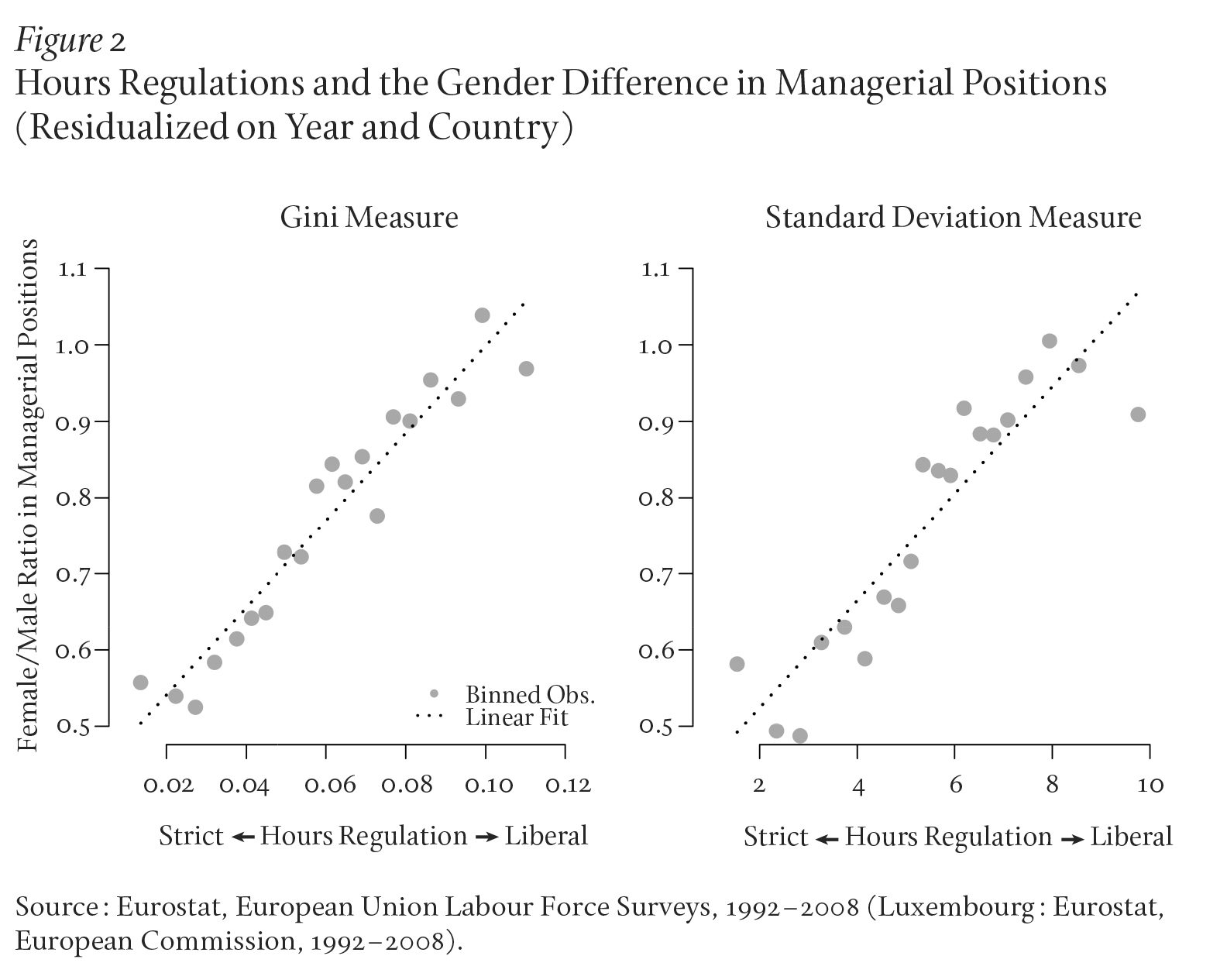
We also find a positive relationship between less restrictive working hours and women’s access to leadership positions between sectors within countries and between countries within sectors.12 Figure 3 shows that the three countries with less restrictive hours regulations–France, Ireland, and the United Kingdom–have relatively more women in managerial positions. Using either measure, hours flexibility corresponds with a higher average share of women in management. Denmark and Germany are negative outliers, and this does not appear to be due to measurement issues since the same pattern emerges if we use International Labor Organization data instead. The two cases clearly deserve closer analysis, but much of the cross-national variance points to differences in working hours regulations.
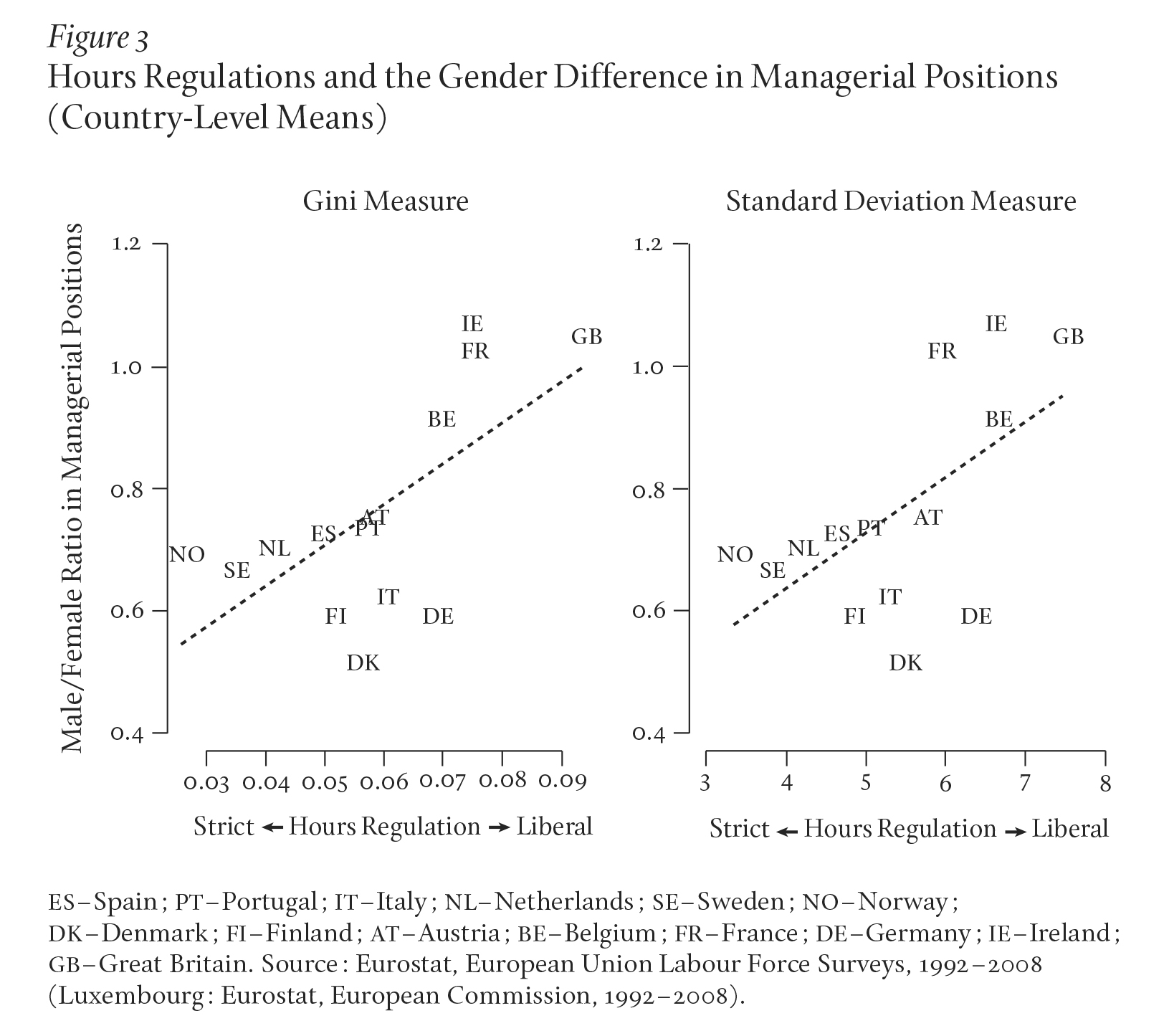
Within sectors, there is a strong positive relationship between lower hours regulation and women in management, except for wholesale and retail, where the line is flat. We surmise that a large number of store managers generally need to be present only during opening hours, and opening hours tend to be more restricted when working hours are also strongly regulated.
Finally, we find that working hours regulations increase women’s share of nonmanagerial jobs, as we can see in Figure 4. This is strongly supportive of our argument that managerial labor markets function differently than nonmanagerial labor markets, and what promotes gender equality in one may hinder it in another.
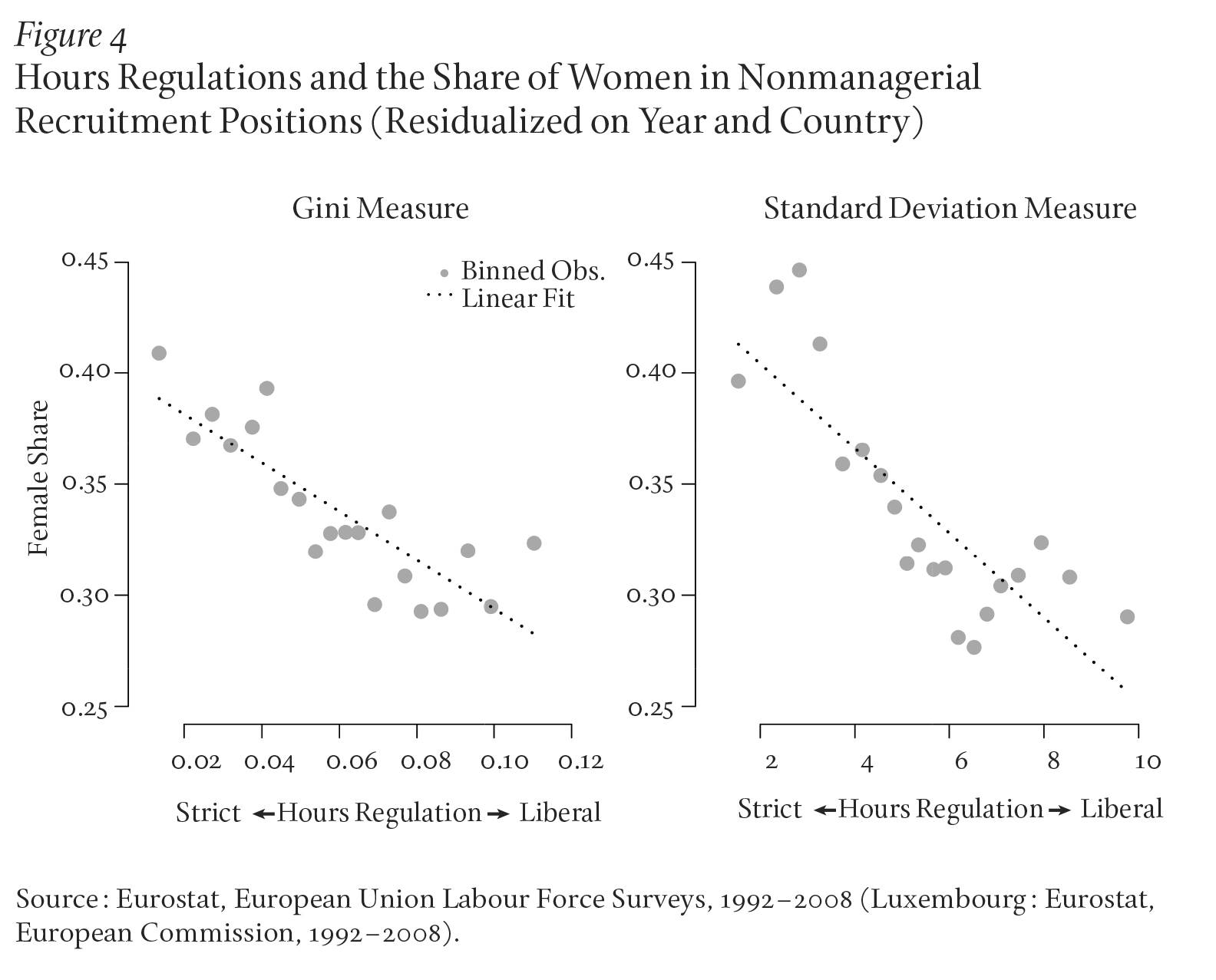
While it is often argued that strict hours regulations help level the playing field between men and women, and while this seems to hold for low- and mid-level jobs, it does not hold for high-powered careers in which the inability of ambitious women to reveal their commitment automatically gives men an advantage. Paradoxically, it is precisely when long hours are most valued by businesses that strict regulations will hurt women, even though more men than women are able and willing to supply long hours.
The obvious alternative explanation for the difficulty of women to break into positions of economic power is that they face a culture of discrimination rising out of traditional gender stereotypes. Undoubtedly there is some truth to this, and policy and business scholar Jette Knudsen’s comparison of promotion decisions by American and Danish firms operating in Denmark suggests that differences in corporate culture do matter.13
Yet it is implausible that a cultural interpretation could account for the general pattern we have uncovered. As we have shown, the effect of hours regulations is the opposite in managerial and nonmanagerial labor markets, which is difficult to reconcile with a single gender norm against women’s employment.
Still, there may be a norm against women in management, which coincides with more restrictive hours regulations. If this is true, however, it is hard to understand why women do so poorly at the top end of the occupational pyramid in countries with strong left parties and a long-standing commitment to gender equality (notably in Scandinavia). Indeed, this commitment is clearly on display in substantial female representation in the national legislature and in government. In Spain, for example, the socialist government pursued a policy of virtual gender parity in both the parliament and the executive, yet women have made few inroads into corporate boardrooms.
Representation of women in the political elite is negatively related to representation of women in the economic elite, as illustrated in Figure 5. Excluding the obvious outlier, Japan (which we discuss below), there is a clear negative correlation of −0.42. This is particularly surprising because over time there is a strong positive relationship between female labor force participation and representation in the national legislature in every country, a relationship that almost certainly also applies to the share of women in management.14 One would expect that women who acquire experience and competences in the labor market, and form strong independent political views in the process, expand the pool of candidates for national elected office.15 Why, then, is there a strong negative cross-national relationship between the share of women in management and in the legislature?
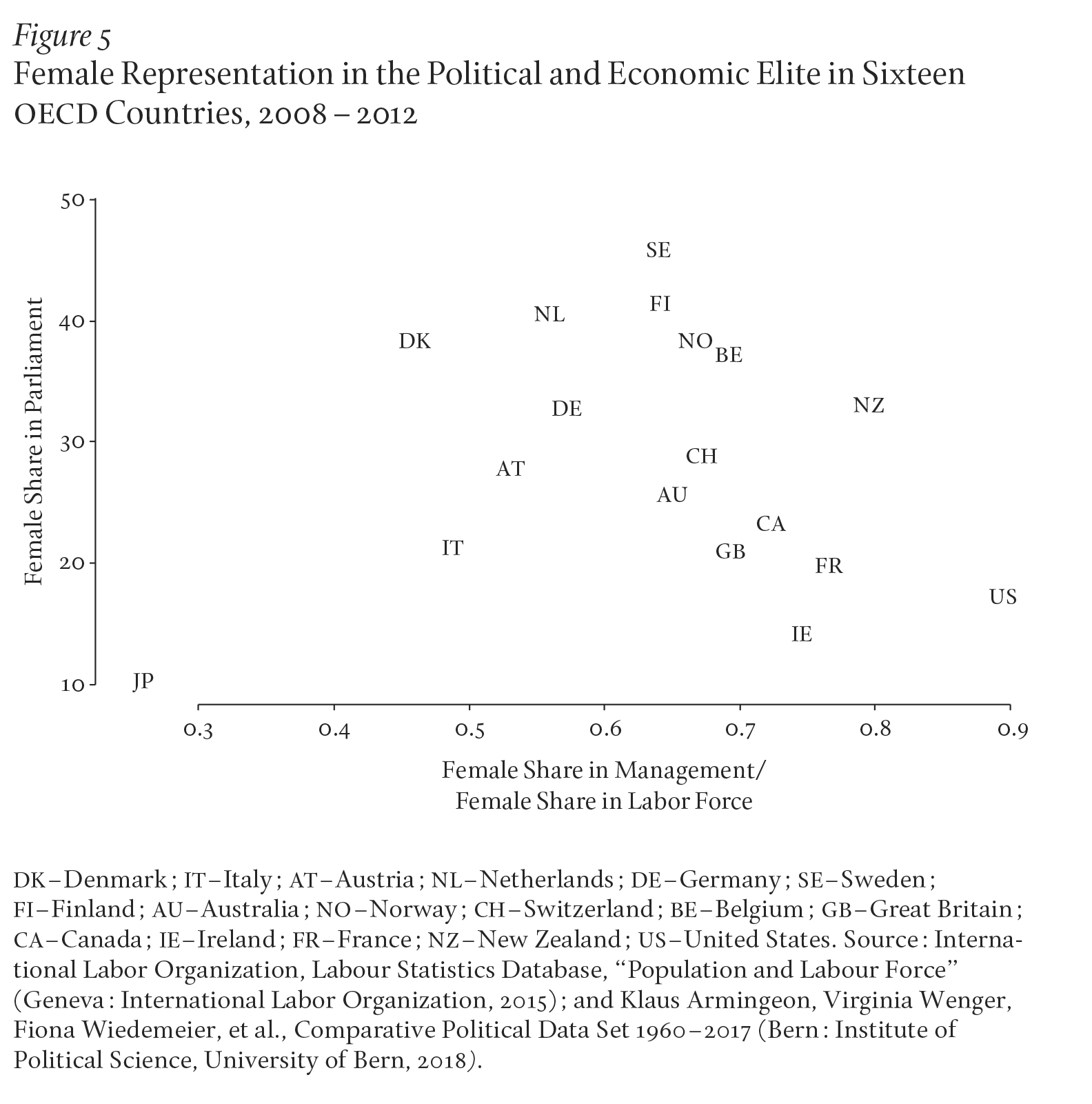
Our explanation goes back to the general model outlined in Women, Work, and Politics: The Political Economy of Gender Inequality. For reasons spelled out by political scientist Thomas Cusack and colleagues, regulated markets and proportional-representation (PR) electoral systems coevolved in the early twentieth century.16 Regulation, associated with both strong insiders and skilled unions, and PR, which produces more center-left government in favor of such regulation, both help explain why it is hard for women to break into the highest positions in business.
At the same time, the electoral system powerfully shapes the incentives and opportunities for women to enter politics. Unlike single-member district systems, PR electoral systems do not require politicians to commit to uninterrupted careers in order to cultivate close relations with their constituencies and to build up bargaining power within the legislature. In closed list systems, PR instead produces strong parties where commitment to the party label is more important than building up personal political capital (which is looked at with suspicion by party leaders). Party-centered systems make it far easier for women to have political careers, compared with candidate-centered ones, and it gives party leaders no (rational) reason to discriminate against women when promoting them through the party organization.
Japan is a significant outlier, combining low female shares in both corporate boardrooms and in the legislature. But the reasons why in fact highlight the logic of our argument. Unlike in Northern Europe, where labor regulations tend to reflect the political strength of organized labor, Japan’s top firms offer job security to compete for scarce skilled labor, despite weak unions. These firms avoid hiring women into long-term labor contracts because women are expected to quit upon childbearing, taking with them the firm’s investment in their human capital. For Japanese firms, women are simply a bad financial bet. In politics, female candidates do more poorly in the single-member districts than in the PR tier, but they do not do particularly well in either one, reflecting the small number of women with managerial or local government experience.
An obvious question raised by this analysis is why women do not help institute reforms of the labor market in systems where they are well-represented in politics. Most women favor labor market regulations because it helps them balance family and career. But for those women who put their career ahead of their family, as many men do, such regulations are a double-edged sword. In a separate paper, we find empirically that career-ambitious women are more likely to lean right than career-unambitious women, all else equal.17 The absence of a level playing field between men and women in a sense pushes ambitious women in the direction of favoring deregulation, and thereby induces a cleavage among women that would otherwise not exist. Women with low- or mid-level jobs are protected from long hours, but ambitious women are largely shut out of corporate boardrooms. This splits the female vote and hampers efforts to present a unified women-friendly policy agenda.
Hours regulation could help workers slow down the rat race.18 The problem for women is that even the slower European work week stretches conventional expectations of motherhood to their limit–seven hours a day–and corporate leadership typically requires longer hours than that. Given the gender wage inequality that results from unequal availability to work, it is hard to dispense with the existing family bargain in which the partner making less money (still, in most cases, the female) shoulders more of the family work in order to free the man to earn more money: the basis for gains from trade within a marriage. Society is caught in a self-reinforcing sexist equilibrium.
Many women, of course, do benefit from the shortened work week. Restrictions on working hours narrow the gender wage gap in lower-level occupations. But they do so at the cost of shrinking the percentage of women who make it up the ladder. Although grasping the net welfare benefits of hours regulation would require more information than we have about selection effects and constrained preferences, our analysis demonstrates, at a minimum, that the decision of whether or not to regulate hours entails substantial distributional consequences across different groups of women. Women who are willing to forgo a family life have a substantially greater chance of career success in an unregulated market than in a system that muffles signals of outlier levels of ambition. However imperfect a marker of productivity and ability, working long hours (one could just as well write “rat” across one’s forehead) replaces gender as a signal in countries without hours regulation.
Until the average woman is able or willing to spend as much time on her career as the average man, a firm would have to pay a wage premium to get gender equality in its upper management. Imaginative public policy could subsidize the costs of family-related absences by providing tax credits or procurement priority to firms that meet desirable targets, thereby socializing the costs of family time now borne by underpaid or nonworking mothers. But any action involving legislation requires widespread political support and the absence of a blocking coalition: a difficult proposition when women’s own preferences about family and work are so widely distributed.
Alternatively, if the average man were able or willing to spend as much time on his family as the average woman, firms would be less likely to view female employees as greater flight risks and gendered statistical discrimination might wither away. Scandinavian countries reserve some portion of family leave for fathers in order to shift gendered family norms, but the rewards of long hours at work in managerial careers are such that few men take more than the minimum fathers’ quota and many forgo their rights to paid leave altogether. This pattern is unlikely to change dramatically until the health, emotional, and social benefits of family engagement are widely touted to outweigh the career benefits of staying in the rat race. And so, the sexist equilibrium persists.
European women not satisfied with a smaller wage gap in the lower rungs are pressing for government-mandated quotas for women on corporate boards, and several European countries have mustered the legislative coalitions to pass the requisite laws. European women dream of leapfrogging the United States, where 40 percent of managers, 15 percent of high-ranking managers, and only a handful of Fortune 500 CEOs are female.19 Early experiments with quotas on boards in Norway generated a backlash in some quarters by the men who feel unfairly passed over and by women who had to bear the burden of proof that they reached the top on merit.20 But Iceland, France, Spain, and the Netherlands are forging ahead with quota laws, and Belgium, Germany, and Sweden are considering similar legislation.21
The quota debate may prove to be constructive in Europe, but it has not gained traction in the current U.S. legal and political environment. Perhaps firms themselves will be motivated by the 2007 McKinsey study that shows that European firms with at least three women on their executive committees outperformed their rivals both in average return on equity and operating profits.22 Although naysayers are quick to argue that only profitable firms could afford the luxury of appointing unqualified females in the first place, the study points out, plausibly enough, that women in leadership positions are likely to be important interpreters of female spending and investment patterns in an era of growing female spending power.
The gender wage gap is smaller in jobs where output is easier to measure than by the shorthand of hours, and perhaps technological or organizational advances in productivity measurement will hasten the trend. Some studies find smaller gender wage gaps in more competitive market niches, although a “macho culture” could deter many women from venturing into some of those occupations. Whatever the current situation, it is a sure bet that firms will not draw more deeply from the pool of female talent until it is profitable to do so, or policy interventions make it so.
AUTHORS' NOTE
We are grateful for exceptional research assistance from Joshua Handelsman, Young-Joe Hur, and Naa Pappoe; for helpful conversations with Joe Altonji, Peter Swenson, and Kathleen Thelen; and for feedback from Nannerl Keohane and the other authors of this Dædalus volume.
